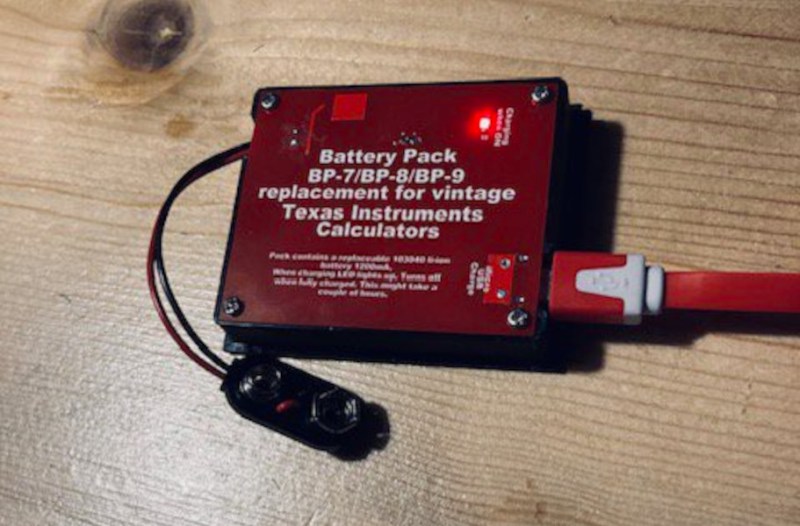Even though Texas Instruments were the first company to produce an integrated circuit and a microprocessor, their success as a company in the 60s and 70s was not guaranteed. At the time there wasn’t much demand for previously non-existent products like these, so to drive some business they built the first hand-held calculator, a venture that they are still famous for today. Since then, though, they’ve become a bit of a punchline for producing calculators with decades-old technology but with modern price tags, so while this business model was quite successful if you want a calculator with a few modern features you’ll have to take a DIY approach like this calculator retrofitted with a LiPo battery.
The modern battery pack, with a lithium polymer battery at its core, includes all of the circuitry needed to integrate it seamlessly into the TI-59 calculator, which is all available on the project’s GitHub page. This calculator originally used a 9V battery, so the new battery pack includes a boost converter to match the 3.7V from the new battery to the needs of the old calculator. It doesn’t stop there, though. The pack is rechargeable from an included USB-C port, has a built-in charge controller, and is housed in its own custom-built case that fits neatly into the calculator where the old battery would sit.
While this wouldn’t be a drop-in replacement for more modern calculators like the TI-83/84 and TI-89, a new case and a different boost converter would solve the problem of the AAA batteries dying during exams. It might make the calculators non-compliant with various standardized testing requirements, though (which TI was also instrumental in developing) so you may want to verify with your testing standard of choice before modifying a calculator you need for an exam. But if all the rules are off, why not add Wi-Fi to it too?

















As far as I know, the Ti-59 featured a removable battery pack that comprised of three Ni-CAD cells in series.
As a TI-58c owner, I can confirm you are correct.
You are absolutely correct, the TI-58, TI-58C, and TI-59 all use a BP-1A pack. A couple of years ago I designed a LiPo BP-1A replacement pack. You can find details here: https://hackaday.io/project/176529-ti-59-lipo-battery-pack
The BP7, BP8, BP9 were used in many models of TI calculators, and I am thrilled that Nico has taken the initiative to make a retrofit pack. I expect the benefits of Nico’s pack to be similar to what I observed with the LiPo BP-1A replacement: significantly increased operating life and “shelf life”.
Bought a HP48SX from eBay for spares/repairs with keyboard top row of button not working.
During disassembly, AAA battery tray shattered, so after fixing the keyboard, I fitted a recycled Samsung Li-Ion battery and that’s what the calculator has been running on for years since.
Downside is the battery is a large 2100mAh battery and it occupies both (? at least one) card slots, but I never use those slots anyway as I don’t have expansion cards.
Charging board is in the battery compartment.
TI-57 used a BP-7 battery pack, that has 2 NiCd cells and an upconverter to 9VDC. But TI-59 had a BP-1A with three nicads and no converter.
http://www.datamath.org/BP_Repair.htm
I hate to be that guy, but they make rechargeable 9v batteries. I’m sure this was a fun exercise in diying something but for what was spent building this you could probably buy more than one rechargeable 9v. We’re just reinventing the wheel here.
Besides the learning effect, there’s also the fact that many of these calculators originally came with an option for a 9V battery or a rechargeable battery pack. If you had the rechargeable, then you didn’t have the plain, flat cover for the battery compartment. The rechargeable battery was part of the cover for the battery compartment. You can use a 9V battery without the rechargeable battery, but the 9V battery will hang out of the compartment. You need to replace or modify the battery compartment cover to convert to a modern 9V rechargeable battery, so you might as well go whole hog and make your own circuit board and use a lithium ion pouch cell.
Mostly, though, it’s because people like to do things.
You could sit down and make Benchies to improve your 3D printing skills, or you can make something useful to improve your skills.
You could design a PCB for a lithium pouch cell then look for something to use it in, or you can design it from the start to be used in a particular device.
Finally, this site is “Hackaday” not “Buyaday” or “Product recommendation a day.” It’s about people making things.
Most nearly any problem can be solved by collecting enough money and throwing it at somebody who can sell you a solution – that’s just not a very fun way of doing things, though.
My TI programmer runs off a 9V battery. However… The 9V battery is about 1mm more thick than the original battery pack, so the cover is bulging. Not an issue in this calculator’s heyday. But now that it’s vintage and collectible, it takes away from the aesthetics.
Many rechargeable 9v batteries output only 7.2v, not enough to get these calculators working reliably.
Unfortunately the TI vintage calculators I found were all totally ruined by battery leakage corrosion. At least I was able to salvage the neat bubble LED displays.
You might want to check what Jack Kilby was doing in 1958, also TI made a single chip microprocessor before Intel made 4004
You can also buy USB rechargable Li-Ion 9V batteries at AliExpress for like 2$, I have a couple and they work really well – stable voltage, fast and easy charge.